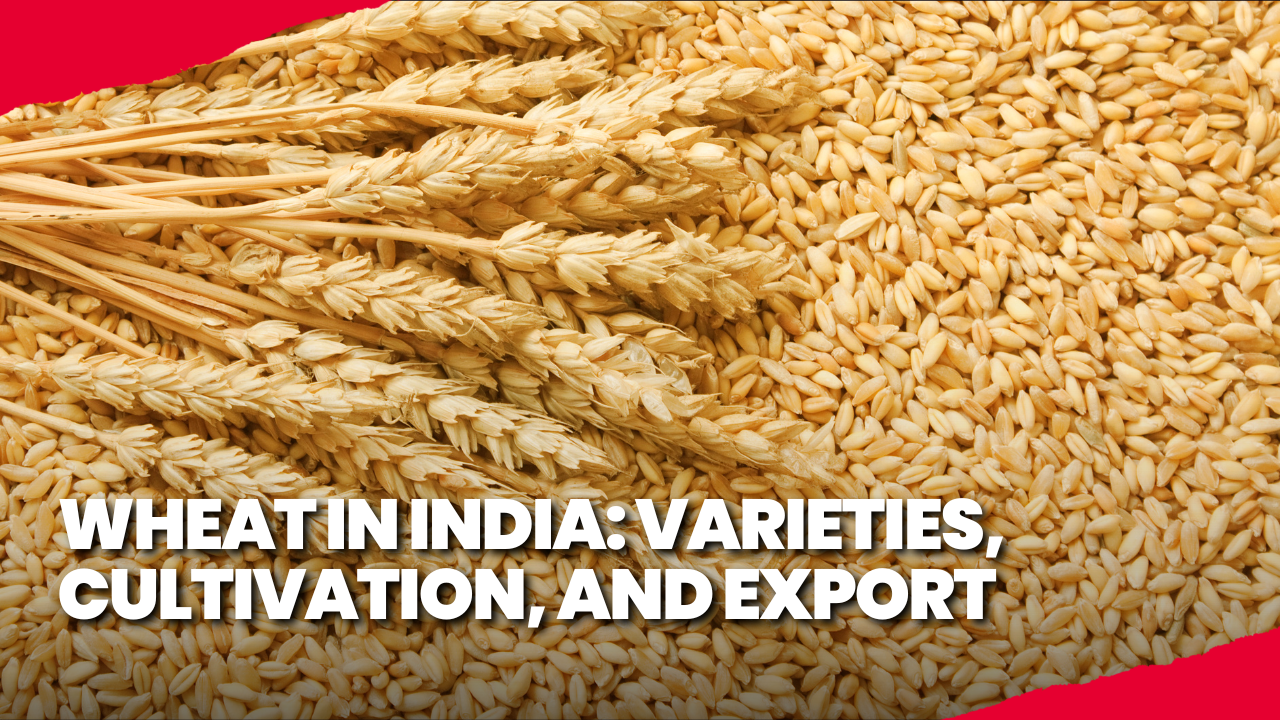
As one of the world’s biggest wheat producers, India’s farmland, business, and daily consumption all depend on it. Wheat is in everything, from the roti on your plate to the pasta you order at a restaurant. India is slowly increasing its share of the world’s supply.
This article explains the main types of wheat in India, the significance of Indian wheat varieties, and the growing scope of wheat exports from India in this international market.
How to Know the Different Kinds of Wheat in India
India’s geography and climate make it possible for a number of different types of Indian wheat to grow. Not only are these served in the country, but they are also becoming more popular in other countries.
Sharbati wheat
One of the best types of wheat is Sharbati, which is mostly grown in Madhya Pradesh. It’s known for being soft, naturally sweet, and high in gluten, which makes it great for making fluffy, soft chapatis.
Lokwan wheat
Some parts of Gujarat and Maharashtra grow Lokwan wheat, which is another famous type.. It’s a favorite in the baking and flour-grinding businesses because it’s a golden color and a little harder.
Durum wheat
India’s Punjab and Uttar Pradesh regions grow a lot of durum wheat. People know it for making pasta and semolina. Strong gluten and a hard texture make it good for food items that need to be flexible.
Sonalika wheat
Then there’s Sonalika, a type that grows well in northern India and has a high output. A lot of people and flour mills use it because it’s well-balanced in terms of nutrition and easy to mill.
Bhalia wheat
Finally, Bhalia wheat is a long-grain wheat grown in Gujarat that is known for having a low moisture level and a lot of carotenes. It’s especially good for people with diabetes and people who care about their health.
Farmers in India can pick the best type of wheat for their land, environment, and market needs because there are so many kinds. India can also meet the needs of a wide range of customers, both in India and all over everywhere, because of its variety.
What are the health benefits of different kinds of Indian wheat?
Wheat is not only a basic food, but it is also very good for you. There is a lot of protein, fiber, and important minerals like iron, zinc, and magnesium in most types of Indian wheat.
As an example:
- About 12 to 13% of Sharbati wheat is protein, and it has a lot of gluten.
- Due to its higher protein and gluten content, durum wheat is perfect for making industrial foods.
- Bhalia wheat’s high carotene content gives it antioxidant capabilities.
India’s wheat is one of their most important foods because it is so healthy. It is used to make everyday meals and special foods.
Also Read This: IDPMS Guidelines: An All-In-One Guide for Indian Importers
The Growth of Wheat Export from India
Since the beginning of the 2000s, wheat exports from India have become much more popular. The Agricultural and Processed Food Products Export Development Authority (APEDA) says that India’s wheat exports were worth more than USD 2 billion in FY 2022–23 alone.
Bangladesh, Indonesia, Sri Lanka, and the UAE are some of the biggest importers. Indian wheat varieties are of high quality, which gives the country an edge in markets in Asia, Africa, and the Middle East.
For food security reasons, the government does sometimes temporarily ban exports when local production is low. Even so, India is still a stable supplier on the world market, especially when there are problems with the international wheat supply chain.
Wheat Export from India has an exciting prospect because of rising demand, better facilities, and laws that help the industry.
Top 5 Importers of Wheat from India (2022–23)
| Rank | Country | Import Volume (Metric Tons) |
| 1 | Bangladesh | 1,000,000 |
| 2 | Indonesia | 750,000 |
| 3 | United Arab Emirates (UAE) | 600,000 |
| 4 | Sri Lanka | 500,000 |
| 5 | Nepal | 400,000 |
Predictions for the future and new ideas
India is always working on making new varieties of Indian wheat that have higher yields, better protection from disease, and the ability to grow in a variety of climates. Agricultural study groups like the Indian Council of Agricultural Research (ICAR) have created new types that can grow in a range of weather conditions. These include HD 3226 and AKAW 5100.
Farmers are using precision farming and drip irrigation to increase yield and decrease environmental impact. Organic and low-gluten wheat exports from India are expanding as the international community moves toward healthier meals.
Wrapping It Up
Wheat growing has a long and interesting past in India. India has shown its strength in agriculture by growing different kinds of wheat and becoming a big supplier everywhere. As international demand and climate change increase, the attention must now be on new ideas, sustainability, and making the most of India’s wheat exports.
Indian wheat is something you should look into if you are a business looking to sell or someone who is looking for good grains.
FAQs
Sharbati, Lokwan, Durum, Sonalika, and Bhalia wheat are the most popular types of wheat in India. Each has its own qualities and is grown in different areas.
India has exported over 4 million tons of wheat in the last few years, mostly to neighboring countries and the Middle East.
Indian wheat varieties are in high demand because of their quality, taste, and adaptability. They are also very affordable, which makes them appealing to buyers in international markets.
Also Checkout Our YouTube Channel: @limeinstituteofexportimport






